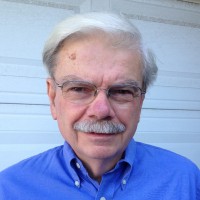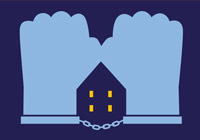It gave him the chills. He was just Chris then, not Professor Zepeda-Millan, and he was still in grade school. On television, during a Martin Luther King anniversary, he saw King deliver I Have a Dream. Manacles of segregation, chains of discrimination, African Americans living on a lonely island of poverty, exiles in their own land . . .
“I can’t believe this happened to black people,” Chris told his uncle John. “Well, similar stuff happened to us,” his uncle said. He cued up Chicano!, a PBS documentary about the Mexican-American civil rights movement. Much of it focused on Boyle Heights, in East L.A., where Chris Zepeda-Millan had been born and was growing up. “What?” he said. “I can’t believe this happened here. I didn’t know this. . . . ”
That was how it began.
Gentrification as injustice
Zepeda-Millan is 37 now, an associate professor of public policy and Chicana/o studies at UCLA’s Luskin School of Public Affairs. His areas of expertise include Latino politics, immigration policy and social movements. His story begins at the home of his grandparents, immigrants from Mexico, whose hard work finally enabled them to buy the modest house where he was raised. On what they earned, even adjusted for inflation, purchasing that home would be impossible in L.A.’s current housing crisis.
Blame gentrification. Like his outrage at what he learned from I Have a Dream and Chicano!, Zepeda-Millan’s indignation at the injustice caused by gentrification is palpable – as is his refusal to abide injustices of any kind. His book, Latino Mass Mobilization: Immigration, Radicalization, and Activism, published last year by Cambridge University Press, documents a wave of protests by up to 5 million people across the United States in 2006 – perhaps the largest demonstration for immigrant rights ever. The protests contributed significantly to the defeat of intolerable anti-immigrant legislation in Congress.
Zepeda-Millan ends his book with a declaration of Latino strength. “We can say with confidence,” he writes, ” . . . that people from Latin America will continue migrating, transforming, and staking their rightful claim as part of the social, cultural, economic, and political fabric of the United States. . . . When met with xenophobic attacks, we can also expect Latinos (with and without papers) to fight back – on the streets and at the ballot box – in defense of their families and communities.
“No president, bill, or wall – no matter how high – will stop us from doing so.”
Growing up in Boyle Heights
A scholar engaged with public issues, Zepeda-Millan chose to be interviewed in public, first at a coffee shop in Echo Park, which proved to be too noisy; then at a table in the park, which grew too warm; and finally on some grass under a tree near Echo Park Lake. He wore his trademark flat cap and a black t-shirt emblazoned with Huelga. Strike!
His parents, he said, separated when he was two years old, and he spent most of his time with his grandparents. They were sweatshop workers. “The house was full of sewing machines, because my grandmother and grandfather would come home, cook, and then start sewing again all night, and yet we were still poor,” he said. “But I didn’t know I was poor. It was an amazing neighborhood. Everybody knew everyone. There were, like, ten other kids within two years of my age. Every day we’d go to school together, come out and play in the streets together.” In the evenings, some of the men would listen to music and have a beer, while some of the women played Mexican bingo, called Loteria. “We kids played hide and seek – on the streets, behind people houses, under cars, on rooftops. It was super fun.
“But in the ’90s, everything started changing. There was a lot of gang activity. . . Boyle Heights was the capital of it. . . . One of my cousins was part of one of the oldest gangs in Los Angeles – White Fence. . . . He got shot in the back and paralyzed, and he spent his whole life in a wheelchair. . . .
“I saw shootings happen. . . . Violence was normalized. It was not uncommon to say, like – ‘Oh, did you hear that this person got shot?’ It was just kind of like the juicy news that happened over the weekend.”
One Sunday, Zepeda-Millan went to Mass with a friend, who joked around. Instead of money, he put a coupon into the collection basket. “We all thought it was funny, and I was, like, ‘Oh, man, you’re going to get punished by God.’ Later on that night, I couldn’t get into my block because it was all taped up, and I saw a body. It was covered in white, but I knew it was him because I saw his shoes. …
“I knew gang members. I went to school with their little brothers, and some of them ended up being in gangs too. But I knew where to avoid, whom to avoid. I played sports. I honestly think that gang members were nice to me because of my cousin. . . . She was, like – how can I say it? – the pretty girl that everybody liked. ‘Hey, tell Vanessa I said hello.’ ‘Hey, Chris, tell Vanessa I said what’s up.’ ”
Challenges, enlightenment
Zepeda-Millan attended Salesian High School in Boyle Heights. It was run by Salesians, an order of Catholic priests. “We had tons of gang members from rival gangs,” he said. “It was the one school where they were all forced to come together. Surprisingly, we ended up creating a brotherhood. If there was going to be a drive-by, they’d tell each other, ‘Hey, man, don’t go to that park tonight.’ All these guys are still my best friends. A couple of us went to college. Ninety per-cent didn’t. Some of us are leftist activists, some are cops. We’re brothers still, no matter what. We’re on the opposite sides of things, but it helps me, because I get to hear their perspectives, and they’re open to hearing some of my ideas, too.”
The Salesians opened their doors early. “They gave us basketballs and things to do from 7:00 in the morning to 9 or 10 o’clock at night,” Zepeda-Millan said. “They’d turn on the lights in the gym for us. Some kids didn’t want to go home. There were problems [at home]. And guess what? The option is to join a gang, hang out on the street, do drugs. But if you have a fun place to be, that makes a huge difference.”
Educational resources were minimal, he said. “Now [Salesian High] offers a much better academic education, [but back then] classes were underfunded and overcrowded. . . . You had immigrant kids, undocumented kids and kids that had been kicked out of public schools. . . . I was a C or D student. . . . I graduated reading at an 8th grade level. . . . [Later on] I literally had to show myself how to read. . . . I didn’t have the qualifications [for] college.”
The Salesians, however, talked Loyola Marymount University, run by the Jesuit order, into accepting him – and giving him a full scholarship.
His Uncle John, who had introduced him to Chicano!, kept encouraging Zepeda-Millan to be proud of his heritage. Chicano, originally derogatory, is short for Mexicano, which comes from the Aztecs, who called themselves Mexica, his uncle said, and their civilization was more advanced in many ways than Europe’s. Zepeda-Millan’s cousin Lucy, who was at UCLA, told him: “Yeah, we’re Chicano. We’re not just Mexican-Americans. We have to learn our history. . . . You have to take some Chicano studies classes.”
A counselor at LMU steered him to Graciela Limon, a Chicana novelist. She set a number of her stories in Boyle Heights. “For the first time, I could relate to what I was reading,” Zepeda-Millan said. “I wanted to read more things I could relate to.” He found them in Chicano studies. “I started devouring everything.” He registered as a political science major, but he ended up double-majoring in political science and Chicano studies.
On the first day of Introduction to Political Theory, his professor, a Jesuit, declared: The church is an opiate of the masses. “He was a Marxist priest who, I found out, was influenced by liberation theology.” Then Zepeda-Millan met the director of campus ministry. “He wasn’t a Jesuit, but he had dedicated his life to the church and to liberation theology. Loyola was at the heart of a lot of activism in solidarity with [the poor in] Central America . . . They paid for us to go to activist training.”
LMU also taught him the importance of graduate school. “Nine/eleven hit,” he said. “My friends who didn’t go to college started enrolling in the military. Immigrant children were signing up. . . . Then, within weeks, there were immigration checkpoints in front of elementary schools, in front of medical clinics. . . . People were being picked up at the bus stop. It was a huge contradiction. I was like, ‘What the hell?’ I’m seeing my community under siege [because of] these horrible attacks that we had nothing to do with.
“I was, like, ‘I need to learn more about immigration and immigrant rights. . . .’
“At the same time, the college Republicans got an infusion of money, and they brought in tons of speakers. They were all anti-immigrant, right-wing speakers. I started seeing people on television talking about 9/11 and immigrants. I started realizing these speakers were saying racist things that just weren’t right. But they were getting the microphone because they had PhDs. . . . That’s when I realized the power of the PhD. . . . I dedicated myself: ‘I need to get the best grades possible, because I need to get into graduate school. . . . I need to be an academic. I need the intellectual ammunition to defend my beliefs.’
“There were zero immigration classes offered at Loyola. I wanted to be the professor I didn’t have. And that’s the way it played out.” Zepeda-Millan became the first Chicano to receive a PhD from the Department of Government at Cornell. He returned to Loyola as an assistant professor. “The first class I taught was immigration.”
From Loyola, he went to UC Berkeley, where he chaired the Center for Research on Social Change. His first classes at UCLA began in September.
Pressure on neighborhoods
None of this might have been possible if his immigrant grandparents had not been able to buy a house in Boyle Heights for $20,000. It’s “not that type of neighborhood anymore, because of gentrification. Now it’s the exact opposite.”
Landlords have raised rents or let their apartments fall into disrepair. Tenants have moved out, whereupon the landlords remodeled and tripled their prices. For homeowners like Zepeda-Millan’s grandparents, the temptation was to sell. Investors knocked on their doors. ” ‘Sell your house! Sell your house!’ . . .
“I remember my grandmother, when I was in college, saying, ‘Oh, a white man came to the door wanting to buy the house for cash.’ She was, like, ‘He wanted to offer me $200,000.’
” ‘No!’
” ‘Do you see how much money we’re going to pay you? We know how much you paid for this house.’
“But my grandmother was, like, ‘I know everybody in the neighborhood. Why would I sell and move?’
“This was happening to everybody. . . .
“Then, all of a sudden, we started getting city inspectors coming in saying, ‘Oh, you have foundation issues. It’s going to cost you thousands of dollars,’ or, ‘Oh, you have that little extra room. You have to demolish it because it’s not up to code – or that’s going to cost you $10,000.’ The city was about to fine an immigrant lady, living off Social Security, $10,000. ‘It’s easier if you just sell your house.’ The city was being used to push people out.”
Many people started moving into cheaper housing farther east, Zepeda-Millan said. “Because of kinship networks, they were moving in with other family members. . . . We know from tons of studies that the more people you cram in, the more tension there’s going to be. People are going to be super-irritable, always arguing. . . . There are horror stories about kids right now. There’s nowhere for them to study. They have to lock themselves in the bathroom to do homework, just to be away from the noise.
“If parents, who are already working so much, have to move an hour farther out. That’s another two hours, going and coming, that they’re not spending with their families. Kids are unsupervised, probably not eating right. [And the parents] have to pay more for transportation. . . . Sometimes they lose their jobs because they’re so far out. . . .
“A lot of suburbs aren’t equipped to have an influx of poor people. The government and private services they need just don’t exist there. People live in poverty, and things get worse and worse.” Maybe they end up on the streets, Zepeda-Millan said. It’s hard to know where many of these people go, he said, because they become difficult to trace, “and it’s going to be the poorest of the poor, which we know are the undocumented.”
Activists respond
“Boyle Heights has a history of activism, so you’re seeing the type of resistance that you haven’t seen in any of the other east side Latino neighborhoods,” Zepeda-Millan said. “There are several organizations. The one that gets the most attention is Defend Boyle Heights. It’s radical, civil disobedience – direct action, I should say. . . . Some gentrifiers were giving a tour of Boyle Heights, and they were going to have an orchestra play in the park for all these white west siders. The local high school band came and drowned them out. . . .
“If an art gallery opens up, they’ll go and graffiti it. They’ll break a window.
“These kids and people my age who still live in the neighborhood, a lot of them majored in Chicano studies, so they have the language, they understand the history, and they’re, like, ‘This isn’t by accident that rents are going up. This isn’t by accident that we have people getting pushed out of their apartments.”
The Center for the Study of Los Angeles at LMU has asked Zepeda-Millan to help design and conduct a study of Boyle Heights as part of a project on LA neighborhoods. “They said, ‘What do you think we should focus on?’
“I said, ‘You have to do housing in Boyle Heights. It’s the most contentious issue right now.’ “

























